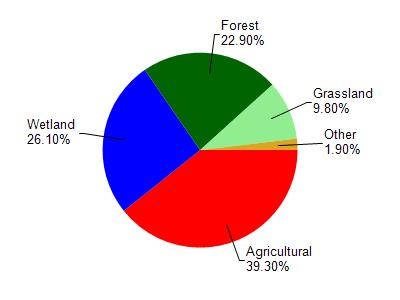Shawano
No
No
No
Fish and Aquatic Life
Overview
, in the North Branch and Mainstem Embarrass Rive Watershed, is a 1.69 acre lake that falls in Shawano County. This lake is managed for fishing and swimming and is currently not considered impaired.
Date 2011
Author Aquatic Biologist
Historical Description
A very hard water spring lake (pond) having slightly alkaline, clear water of moderate to high transparency. The predominant littoral materials are muck (60 percent) and sand (25 percent) along with gravel (12 percent) and some boulders. The shoreline is predominantly wetland of the coniferous-shrub and bog type. Fish species present prior to chemical treatment were brook trout, white sucker and various species of minnows.
This pond has recently been dredged and chemically treated with Fintrol to enhance the trout fishery (1967). Restocking the brook trout is planned. Lake may be of limited value to waterfowl. Public access with parking is available. A farm is located nearby on the shoreline. A water control structure having approximately 1-1/2 head feet is located at the outlet. The entire shoreline for a depth of six rods is leased by the Bureau of Fish Management. The outlet stream is tributary to the north branch of the Embarrass River. Source: 1968, Surface Water Resources of Shawano County Sportsman Lake, T28N, R11E, Section 12 Surface Acres = 2.0, S.D.F. = 1.51, Maximum Depth = 10 feet
Date 1968
Author Surface Water Inventory Of Wisconsin
Condition
Wisconsin has over 84,000 miles of streams, 15,000 lakes and milllions of acres of wetlands. Assessing the condition of this vast amount of water is challenging. The state's water monitoring program uses a media-based, cross-program approach to analyze water condition. An updated monitoring strategy (2015-2020) is now available. Compliance with Clean Water Act fishable, swimmable standards are located in the Executive Summary of Water Condition in 2018. See also the 'monitoring and projects' tab.
Management Goals
Wisconsin's Water Quality Standards provide qualitative and quantitative goals for waters that are protective of Fishable, Swimmable conditions [Learn more]. Waters that do not meet water quality standards are considered impaired and restoration actions are planned and carried out until the water is once again fishable and swimmable
Management goals can include creation or implementation of a Total Maximum Daily Load analysis, a Nine Key Element Plan, or other restoration work, education and outreach and more. If specific recommendations exist for this water, they will be displayed below online.
Monitoring
Monitoring the condition of a river, stream, or lake includes gathering physical, chemical, biological, and habitat data. Comprehensive studies often gather all these parameters in great detail, while lighter assessment events will involve sampling physical, chemical and biological data such as macroinvertebrates. Aquatic macroinvertebrates and fish communities integrate watershed or catchment condition, providing great insight into overall ecosystem health. Chemical and habitat parameters tell researchers more about human induced problems including contaminated runoff, point source dischargers, or habitat issues that foster or limit the potential of aquatic communities to thrive in a given area. Wisconsin's Water Monitoring Strategy was recenty updated.
Grants and Management Projects
Monitoring Projects
| WBIC | Official Waterbody Name | Station ID | Station Name | Earliest Fieldwork Date | Latest Fieldwork Date | View Station | View Data |
|---|
| 304600 | Sportsman Lake | 10022262 | Sportsman Lake | | | Map | Data |
|

Watershed Characteristics
Sportsman Lake is located in the North Branch and Mainstem Embarrass Rive watershed which is 312.62 mi². Land use in the watershed is primarily agricultural (39.30%), wetland (26.10%) and a mix of forest (22.90%) and other uses (11.70%). This watershed has 488.32 stream miles, 1,175.84 lake acres and 51,339.03 wetland acres.
Nonpoint Source Characteristics
This watershed is ranked High for runoff impacts on streams, High for runoff impacts on lakes and High for runoff impacts on groundwater and therefore has an overall rank of High. This value can be used in ranking the watershed or individual waterbodies for grant funding under state and county programs.However, all waters are affected by diffuse pollutant sources regardless of initial water quality. Applications for specific runoff projects under state or county grant programs may be pursued. For more information, go to surface water program grants.